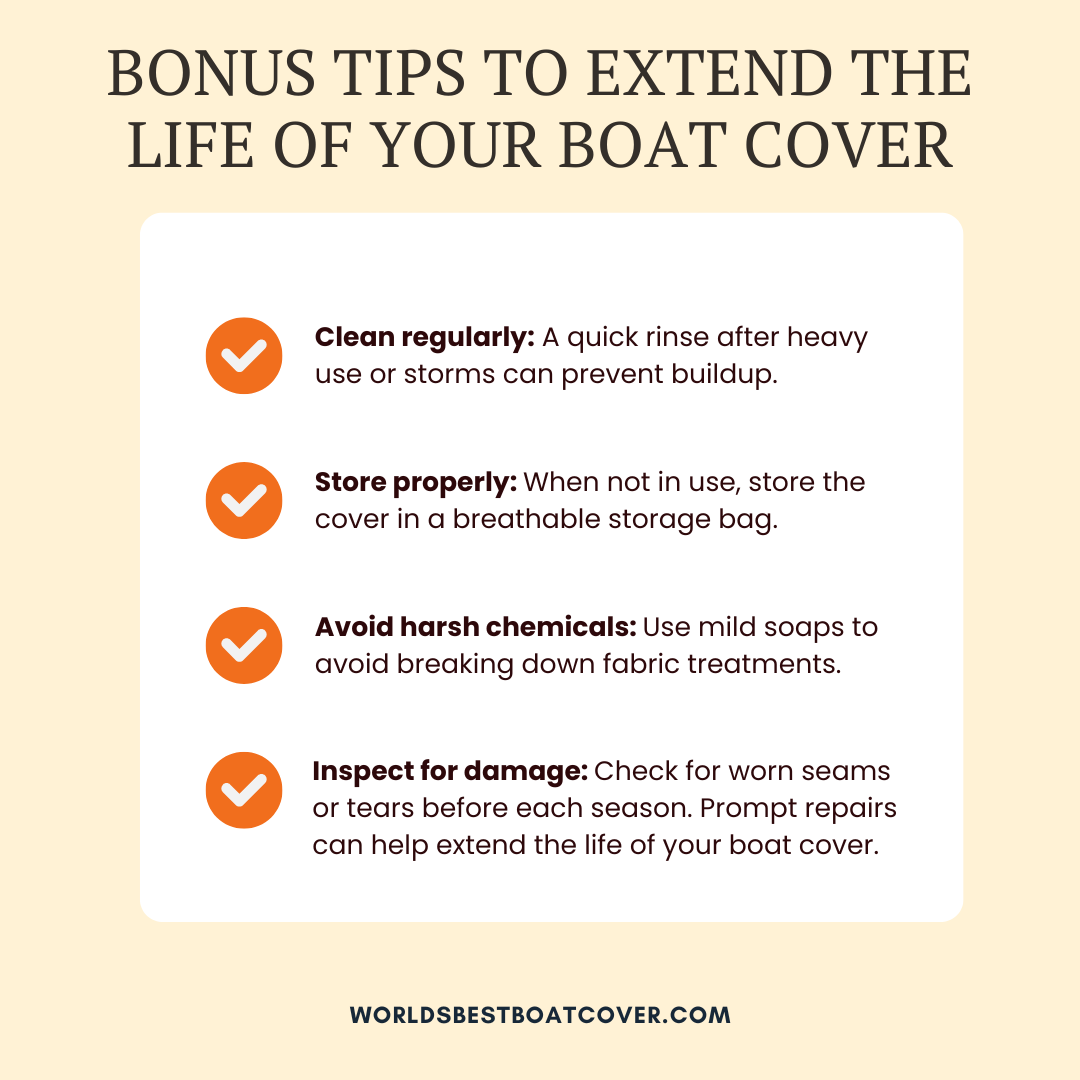A quality boat cover is one of the best investments you can make to protect your vessel from UV rays, salt, debris, and the harsh marine environment. But even the best cover won’t last without regular maintenance.
At Marine Concepts, we’ve spent decades building custom boat covers tough enough for everything from humid climates to high-altitude UV exposure—so we know exactly what it takes to keep those fabrics performing at their best.
In this guide, we’ll show you how to clean a boat cover the right way, based on our experience and marine-grade best practices.
Let’s face it—over time, boat covers collect everything from dust and debris to mildew and stubborn stains. Without regular cleaning, these contaminants can break down the fabric’s protective coating, reducing its water resistance and ability to protect your boat.
Cleaning your cover the right way:
Before you start, gather the following supplies:
Using the right supplies is key to avoiding damage and maintaining performance.
Start by shaking or gently brushing the cover to get rid of loose dirt like leaves, sand, and dust. Using a soft bristle brush is best—it’s firm enough to remove debris but gentle on the fabric. Pay extra attention to seams and folds where dirt tends to collect.
If the cover is really filthy, a quick rinse with clean water before scrubbing is a good idea to soften stuck-on debris.
Bird droppings and mildew can be stubborn. Use a spray bottle filled with a mix of mild soap and water to pre-treat these areas. Let the solution sit for a few minutes to loosen up the mess. Avoid using bleach or harsh cleaners, which can strip the protective coating off the fabric.
Gently scrub the stained areas with your soft bristle brush until the stain begins to lift.
Once the tough spots are addressed, mix mild soap with water in a bucket. Dip the brush into the soapy water and gently scrub the entire surface of the boat cover in sections. Work from top to bottom to prevent dirt from dripping onto cleaned areas.
For very large covers, you might find it easier to lay the cover flat on a clean driveway or lawn.
Pro Tip: Avoid using harsh cleaners or pressure washers, which can damage the fabric’s protective coating. We also don’t usually recommend reapplying fabric guard or water-repellency sprays — in some cases, doing so may void the fabric’s warranty. Always check your manufacturer’s care instructions before applying any treatment.
After scrubbing, rinse the entire cover with fresh water. Make sure all soap residue is removed, as leftover soap can attract dirt or reduce water resistance. It might take several passes with the hose or multiple buckets of water, depending on the size of your cover.
Never pack up or store a damp boat cover. Doing so is a recipe for mildew growth. Instead, air dry your cover fully before using or storing it. Hanging it over a fence, rail, or boat lift works well, allowing airflow to speed up drying.
Avoid using a machine dryer or exposing the cover to direct heat sources like space heaters, as this can damage the fabric.

Beyond regular cleaning, here are a few expert tips to help you get even more life out of your boat cover:
If your boat cover has zippers or snaps, keeping them lubricated prevents corrosion and makes it easier to put the cover on and take it off. Use a marine-grade zipper lubricant or beeswax, applying sparingly and wiping off any excess.
Even if your cover is air dried before storage, keeping it in a damp environment (like the bilge or a humid garage) can lead to mildew growth. Store it in a dry, ventilated spot whenever possible.
Using a support pole or frame under your cover helps prevent water pooling, which can stretch or damage the fabric over time. Pooling water can also compromise water resistance and lead to mold or mildew.
Even if your cover looks clean, small amounts of loose dirt or salt residue can degrade fabric over time. Give your cover a quick clean before putting it away for extended periods.
1. How often should I clean my boat cover?
A deep clean once or twice per season is ideal, especially before long-term storage. Spot clean as needed after heavy use or storms.
2. Can I use a pressure washer to clean my boat cover?
It’s not recommended. High-pressure water can break down fabric coatings and weaken seams. Stick to a soft brush and hose.
3. What’s the best cleaner for a boat cover?
A mix of mild soap and water is best. Avoid bleach, ammonia, or strong detergents that can damage UV-resistant and water-repellent treatments.
Knowing how to clean a boat cover properly is one of the easiest—and most effective—ways to protect your investment. With gentle cleaning techniques, consistent upkeep, and an occasional fabric guard reapplication, you can extend the life of your cover and safeguard your boat for the long haul.
Because at the end of the day, a clean cover means a cleaner boat, fewer repairs, and less hassle every season.
Need a new cover?
Explore the World’s Best Boat Cover—our patented custom boat cover track system is hand-crafted using the highest-quality marine fabrics to protect your boat in any condition, year-round.